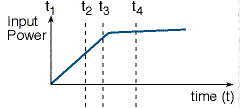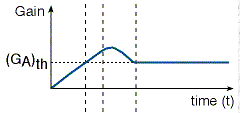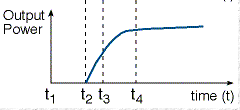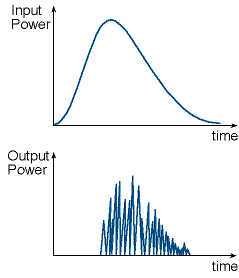محاضرة 14 فيزياء الليزر التذبذب المستقر وتشبع الحصيلة
Steady State Oscillation and Gain Saturation
Population in version and pumping threshold condition
From the equation of small signal gain one can conclude that the population inversion required for reaching the lasing threshold:


At threshold the population inversion

Note that the lasing threshold will be readily when g(v) is maximum at v = vo corresponding to the center of the natural linewidth.


Pumping power required to reach threshold condition
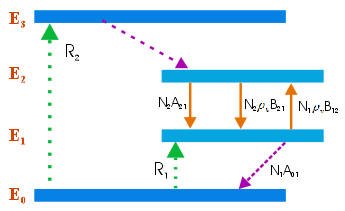
To find the power required for a 4-level laser system to reach the threshold we will use the rate equations.
First we assume that E1>>KT so the thermal population of the energy level 1 is negligible.
Second we assume that the population of the ground state does not change during lasing action.
R1 and R2 are the rate of pumping then the rate equation for the population for the change in N2 and N1


In steady state condition dN2/dt = dN1/dt = 0 ( we assumed that g1=g2and R1=0)
By solving the above two rate equations we get
![]()

and hence

For population inversion A21<A10 or T21>T10 (The upper lasing level has a longer spontaneous emission life time than the lower level.
In most laser T21>>T10 and hence (1-A21/A10) ≈ 0
At threshold
At threshold the radiation density rv is very small and we can assume that (rv=0)
 *
*
In steady state
In steady state situation the gain becomes equal to the losses then we can write
(N2-N1)ss = (N2-N1)th
 **
**
From equations * & ** we get

and hence the radiation density ρv

This mean that the power output is directly proportional to the pumping power within the laser cavity
يوضح الشكل التالي علاقة كلا من pumping power و Gain و laser power كدالة في الزمن
|
| At time t1 the excitation mechanism is activated. As a result, the active medium gain and loop gain increase. At time t2 the active medium gain is equal to the threshold gain, and the round trip gain is equal to 1. Lasing starts, and output power of the laser start to increase. At time t3 the input power reaches its steady state (constant input power). The active medium gain is a little above threshold, and the round trip gain is a little above “1”. until t4, when it reaches its steady state value. Then the active medium gain is equal to the threshold gain, and the gain is equal to “1”. |
Gain saturation in homogeneously laser
In a continuous wave laser (CW Laser) at steady state lasing, the gain (G) is always “1”. At this state, the gain value for each longitudinal laser mode is dropping from the value of the small signal gain to the threshold gain Gth, which is equal to the saturation gain. Increasing pumping cause an increase in the output power of the laser. The system will stabilize on higher power when the net gain will be equal to the threshold gain.
The active medium gain depends on population inversion, and the width of the laser line shape. This gain is influenced by the lasing process itself, since lasing change the population inversion conditions. Stimulated emission causes depletion of the upper laser level, and reduces the population inversion. Thus, gain is reduced until pumping increase the upper level population again.
في الشكل الموضح أدناه نلاحظ ثلاثة أنماط اهتزازية تحت منحنى الحصيلة يتحقق عندها شرط أن الحصيلة اكبر من أو يساوي الخسارة. وحيث أن شعاع الليزر يتولد نتيجة لعملية الانبعاث الاستحثاثي stimulated emission , والتي بدورها تقلل من فارق التعداد وهذا سيؤدي بمنحنى الحصيلة إلى النقصان حتى يصل إلى حد الحالة الحرجة Threshold condition. أما بالنسبة للأنماط الاهتزازية الثلاثة فهي لكل منها تردد خاص وبنقصان منحنى الحصيلة يختل شرط الحصول على ليزر لبعض منها حتى لا يبقى إلى نمط اهتزازي واحد وهذا ما يعرف single mode laser.

|
|
Gain saturation in non-homogeneously laser
في حالة الليزر ذو الاتساع الغير متجانس فإن الامر يكون مختلف تماماً لأنه يمكن التمييز بين مجموعة من الذرات ومجموعة اخرى من ناحية التردد المنبعث تحت منحنى الحصيلة، وعليه لإن انتاج الليزر يؤدي إلى نقصان الحصيلة فقط عند الترددات التي يحدث عندها الليزر فقط أي عند الانماط الاهتزازية التي يتحقق عندها شرط الحصيلة اكبر من الخسارة. وهذا سوف يحدث ما يسمى hole burning كما هو في الشكل ادناه.
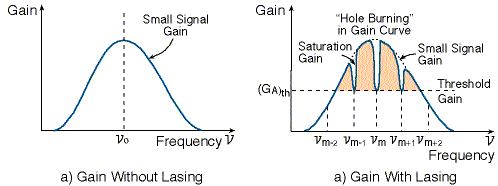
The value of the saturation gain drops for each lasing mode, from the small signal gain to threshold gain Gth
This process is called “hole burning” in the gain curve.
|
|
Pulsed Laser
Pulsed laser is pumped at high intensity for a short period of time. As a result, the active medium gain, and the loop gain are much higher than for continuous wave laser, so the output power is higher.
Pulse Shape Out of a Pulsed Ruby Laser
Figure below describes the shape of a single pulse out of a Ruby laser, compared to the pumping pulse from the flash lamp.
|
| نعلم ان الضوء الصادر من الفلاش هنا يستخدم كوسيلة لقلب التعداد في بلورة الروبي (الياقوت) والشكل المقابل يوضح العلاقة بين شدة إضاءة الفلاش مع الزمن. |
| بالمقابل نلاحظ في الشكل الخاص بتغير شدة الليزر مع الزمن نلاحظ أن الشدة تتغير بين قيمة عظمى وصفر في خلال فترة بقاء ضوء الفلاش وهذا ما يعرف بظاهرة الشرارة Case Spiking. لاحظ هنا ان الليزر يبدأ بعدة فترة زمنية محددة من بدأ الفلاش وهذه الفترة الزمنية لازمة للوسط ليصل إلى حالة الحصيلة أكبر من الخسارة. |
Single pulse out of a Ruby laser, compared to the pumping pulse from the flash lamp
The output laser pulse is about 1 millisecond, and it is composed of hundreds or thousands of small pulses. Each of the small pulses is called aspike, and last about a microsecond. The spikes appear randomly in time, and differ from each other in its length and peak power.
Explanation of the Case Spiking
The linewidth of a laser beam from a solid state laser is more than 30 [GHz] (3*1010 [Hz]). Each line has hundreds of longitudinal modes in it. For each of these modes.
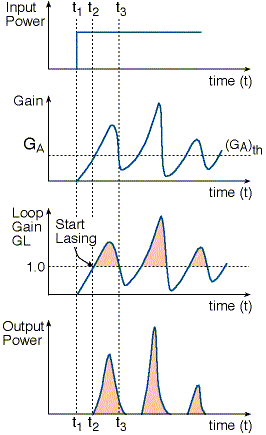 | Starting from t1, the active medium gain and the loop gain increase rapidly as a result of continuous strong pumping. At time t2, the active medium gain arrive to the threshold value, and the loop gain arrive to “1” – lasing starts. The active medium gain and loop gain continue to rise since the output power has not reach the saturation value that cause “hole burning” in the gain curve. Until time t3, the high value of the loop gain causes intense pulse of laser radiation. Thus, the active medium gain drops below the threshold value. When the loop gain is below “1”, lasing stops, and the whole process starts again as long as the pumping continue. |
Gain and output power from a pulsed solid state laser.
Each longitudinal laser mode starts at a different time, with a different photon. There is a competition between the longitudinal modes on the energy inside the active medium. Thus, the random nature of the spikes: Each spike has its own peak power and duration.


